It is not uncommon to put things in pockets and then forget about them. Who hasn’t found money in the pocket of a coat after not wearing it for ages? Occasionally, we also find things in the pockets of clothing items donated to the State Historical Society of North Dakota. As expected, handkerchiefs and gloves are the most common, but every so often something a little more interesting shows up.
This cute green wool coat was made by Steve Abraham, uncle of Carol Sieler. Sieler purchased the materials for the coat but didn’t have the time to make it herself. When her uncle, a professional tailor, was visiting he offered to make the coat for her. Armed with just a few measurements and a general description of a clutch coat with no buttons, he designed and sewed the coat. After wearing it, however, Sieler realized she needed buttons and asked a local seamstress to add buttonholes and buttons. Her uncle was very disappointed when he found out because these were not tailored buttonholes as he would have made.
Sieler’s story gave us great history behind the coat, but it was a fun surprise when we found money in one pocket. While only a dime, the discovery reminded me of the advice women were given prior to cellphones to always carry a dime (and later a quarter) to use in a pay phone in case they needed to call for help.
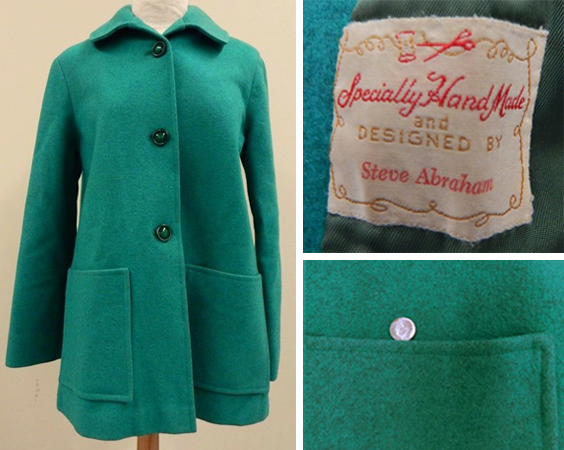
This green coat was tailor-made by the donor’s uncle in 1984. Found in the pocket: a single dime, which at one time was enough for a phone call. SHSND 2018.39.1
During World War I standard rations for American troops included cigarettes. Smoking helped to pass the time and was thought to help calm the nerves of soldiers in combat. This might explain why we found the remnants of a cigarette pack and two wooden matchsticks in the back pocket of a pair of U.S. Army uniform pants. This pair of pants was worn by Ralph J. Rubish of Fairmont. He enlisted May 5, 1917, at Wahpeton and was sent overseas Dec. 14, 1917, serving on the front line with Company I, 164th Regiment, 41st Infantry Division. Rubish survived the war and returned to farm in Richland County. He died in 1961 when he was 62.
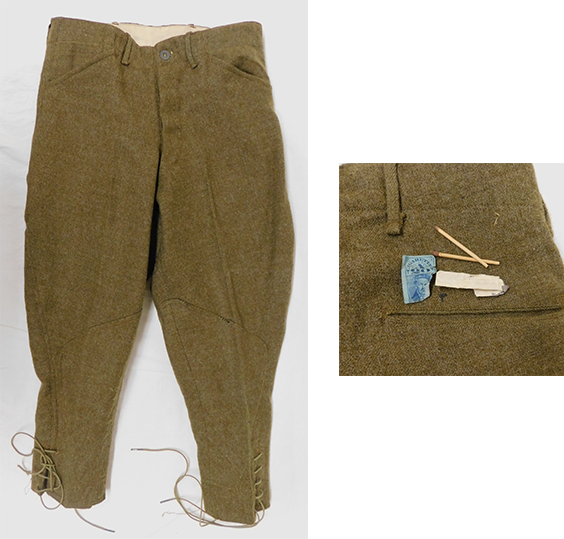
The finds in this World War I uniform attest to a time when smoking was a widely practiced pastime. SHSND 15303.2
Blizzards in North Dakota are not uncommon and make travel difficult. In 1904, Henry H. Nelson and his mother got off the train in Streeter, expecting to be met by his uncle Charles Halvorson. But a blizzard kept Halvorson from meeting the train, forcing the family to find a hotel room for the night. The next day, wearing this raccoon fur coat, Halvorson arrived in Streeter with a sleigh and team of horses. Nelson said that he and his mother were wrapped up in bison robes while Halvorson, snug in his coat, led the team on foot through a blizzard across the prairie to his sod home. When our agency received the coat, we found two blocks and many smaller chunks of pressed tobacco in the pockets. Halvorson could have been a smoker and wanted to be prepared in case he got caught out in a blizzard. But the tobacco found in each pocket suggests it was placed there as an attempt to keep moths out of the fur. Using tobacco as a pest repellent was not uncommon in the past, though it actually attracts bugs, not repels them.
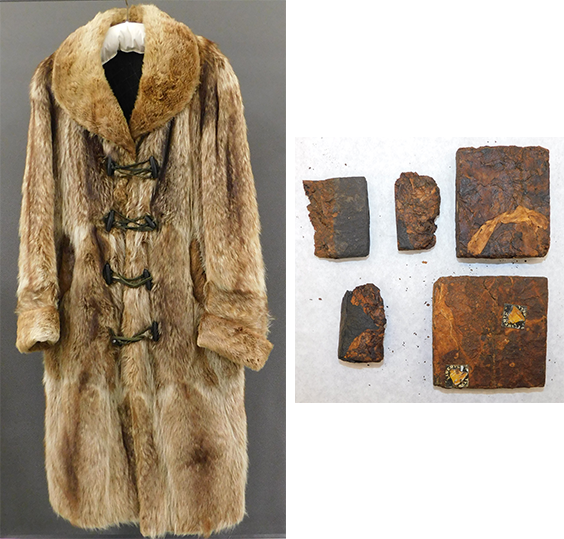
Our curators found chunks of pressed tobacco (right) in the pockets of this lovely fur coat. SHSND 2023.8.1
In 1970, Jane Nissen made an adorable coat for her daughter Susan Nissen. Susan, who grew up in Fargo, tells us that her mother was not only talented but also frugal. The outer cloth was recycled from a woman’s coat, and the lining was from a man’s overcoat. The coat design was based on one her mother saw in a Sears catalog. In the left breast pocket, we found a sticker in the shape of lips with the text, “Beauty shop ladies like red shiny lips.” There was no indication where Susan picked up this sticker but maybe it was a reward for being good while her mother spent time at a beauty shop.
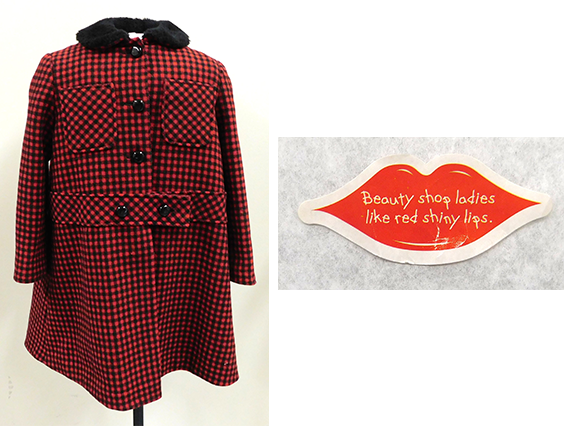
We found a saucy sticker in a pocket of this 1970 coat. SHSND 2016.33.20
According to the backstory of the apron pictured below, the cloth was made in Germany in 1834 and brought to America in 1868. But the apron was sewn and embroidered with a chain stitch sewing machine. Chain stitch embroidery machines weren’t available until 1868. So while the cloth might have been made in Germany, the apron was most likely created later in the United States.
What is even more interesting is what we found in the pocket: a note and a dried geranium leaf. The note tells us that the leaf was taken from a plant salvaged by W.P. Duruz, a professor at Oregon State College (now Oregon State University). Duruz was the chief food and agricultural officer with the Third Army after World War II when he “liberated” the geranium from Adolf Hitler’s garden at Berchtesgaden. He donated the plant to Oregon State College. The undated note, written sometime prior to June 1960 when we received the apron, also states the geranium was blooming profusely in its new home. Unfortunately, we don’t know how or why Mrs. Hugh White of Pierre, South Dakota, ended up with the leaf or what connection the apron has to North Dakota.
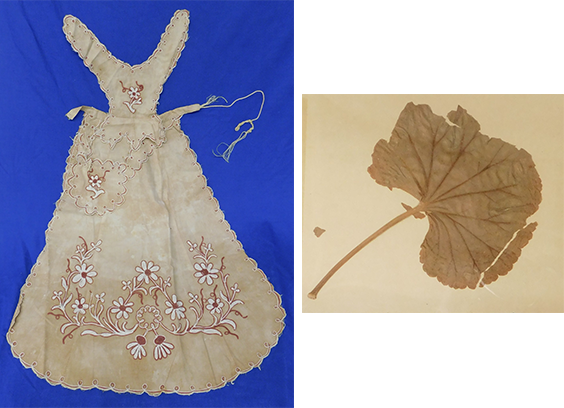
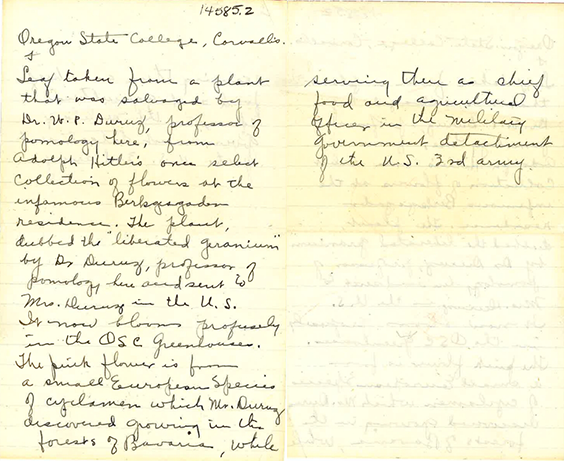
The geranium leaf and note found in this apron’s pockets hold a fascinating connection to World War II. SHSND 14585.1-.2
As you can see from these examples, the contents of pockets can tell us a bit about the person who wore the garment or a little about the times in which the garment was worn. But even when only a sidenote to history, items in pockets are always a fun find for curators.

